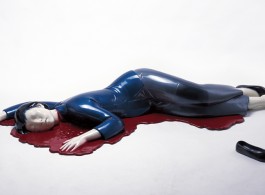[Press Release]
Liu Hulan didn’t know Saint Sebastian, while Yu Fan thinks he does; Saint Sebastian didn’t have a chance to know Liu Hulan, while Yu Fan thinks he does. Yu Fan believes that he can go to and from between two completely different eras: Ancient Rome and Modern China. He chose to dialogue with these two sacrificial characters. The reasons behind the dialogue itself might be complicated, but the reason for the sacrifices was simple: it was for their beliefs. Bloodshed is inevitable for heroes, and could be regarded as part of history. Saint Sebastian was shot against a column by arrows; Liu Hulan was killed by a hay cutter. These two historical events are not related. Why does Yu Fan re-create these two characters in the form of contemporary sculptures and let us link them through his creations?
These two deaths have been modernized. The realism of the events surrounding these agitational and tragic characters of Renaissance and Revolution has been obliterated. The slick lacquered surface of the sculptures prevents the restoration of historical truth, and marks the beginning of aformalisticsubjective game.This game is a vehicle for deconstruction by playful interpretation. Like some of the strategic moves of post avant-garde YBA, the emphasis is not on rupturing history, but on deepening the relationship with history. Actually, an artistic attitude from post modernism is affecting Chinese artists. It is strange to me that characters from Yu Fan’s own Province, such as Confucius and Mencius, are absent from hishistorical context. Maybe it is because whilstthey had strong beliefs they didn’t die for them. Their blood remained circling inside their bodies and never flew out. Nor did metallic blunt instruments damage the intactness of their bodies. Perhaps these are the reasons why Yu Fan’s historical subjects were taken fromShanxiProvinceinstead of his nativeShandong.
The parallelism betweenSaint Sebastianand Liu Hulan from Shanxi,rather thanConfucius from Shandong, is a distinct image which plays out in our minds as a single-act play of history, anti-history or ultra history. In today’s time when belief is ever weakening, the arrows in SaintSebastian’s body are like teeth mocking those happy souls going in and out of churches. This pair of teeth flashes onCentury Auditorium*, as well as in endless dirty jokes. And that evil and sinful hay cutter seems to become a handy shaver, marching up and down those male celebrities’ faces, leaving no blood stain nor wonder behind. We remember the greatness of life and forget the glory of death. This historical single act play is flat; the blood is nothing more than symbol.
I believe that the successor of Liu Hulan will get to know the successor ofSaint Sebastian in this play, just as it could be Liu Hulan whom the arrows pierced through, or Saint Sebastian’s head which the hay cutter cut off. Cruel practices of different nations exchange with each other. Is it a special conversation between two specific young men? Saint Sebastian and Liu Hulan were portrayed in a fixed form by their own cultures and ideologies. These forms have their own integrity that prevents Saint Sebastian from meeting Liu Hulan, and visa versa. But in Yu Fan’s world, they met and got together. History was extended into an uncertain reality.



